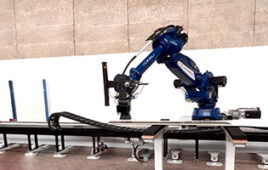Managers at Minnesota-based Form-A-Feed, a maker of livestock feed, planned a new production line as they saw business growing. As part of the planning process, Form-A-Feed called on engineers from Hamer-Fischbein, a company that designs and integrates bagging equipment and Yaskawa Motoman robotic packaging solutions. The engineers looked at ways to boost speed so the feed maker could bag and palletize products at its South plant production facility. Because the feed company’s North plant uses bagging equipment and a robotic palletizer, the robot integrator looked at the needs for the new line and also assessed Form-A-Feed’s experience with its existing equipment.
Form-A-Feed and the robot integrator agreed that installing a second, automated palletizing line in the South plant was the right course of action. But Form-A-Feed wanted to avoid the programming challenges it faced with the North plant’s automated line. For example, when changing the configuration of pallets for the North plant’s line, the production facility’s supervisor would have to stop production, turn off the robotic palletizer and plug in a laptop to instruct the robot to handle a new size of bag and pallet. Automating the bagging and palletizing process saved time at the North plant, but the time-consuming programming steps for the changeover process reduced the cost savings gained from automation.

Another challenge for Form-A-Feed was the footprint allotted for installation. Managers wanted to leave room in the South plant for other operations. The space for the South plant’s new line was “L” shaped, measuring approximately 370 m2.
The focus for the project was designing a bag palletizing solution that ensured less robot downtime, was easy to program and increased productivity for the South plant. To simplify the challenges of the existing solution and fit the system inside a relatively small footprint, the engineering team designed a new, semi-automatic line for the South plant, including a duplex Hamer 600NW Belt Feed bagging scale, which dosed product to a 1200BH bag hanger. The system also included two conveyors and a Hamer RPM Robotic Palletizing Module which includes an MPL160 robot and controller. This is a 4-axis robot with 160 kg payload.
 Robotic palletizing made easier
Robotic palletizing made easier
The integrators installed the system at Form-A-Feed, and managed to fit the required technology inside the footprint. To operate the line, one worker facilitates the bag-labelling step along a conveyor and positions bags before they reach the sew-top sealer. After the bags are filled with product, they travel along a second conveyor and are picked by the robot and placed on one of two pallets located on either side of the robot’s station. A second worker removes completed pallets with a forklift and takes these to a wrapping station for shipping.
At the South plant, the installation took two visits, and product changeover now happens faster.
The South plant’s palletizing line now operates at 20 bags per minute (BPM)—slightly faster than the North plant’s line. However, it is often the scale or bagging machine that sets the pace of total production. For instance, the 1200BH bag hanger runs at a maximum rate of 18 to 20 BPM; the MPL160 robot can operate much faster depending on the size of the bag.
Yaskawa Motoman
www.motoman.com
Filed Under: Robotics • robotic grippers • end effectors





Tell Us What You Think!